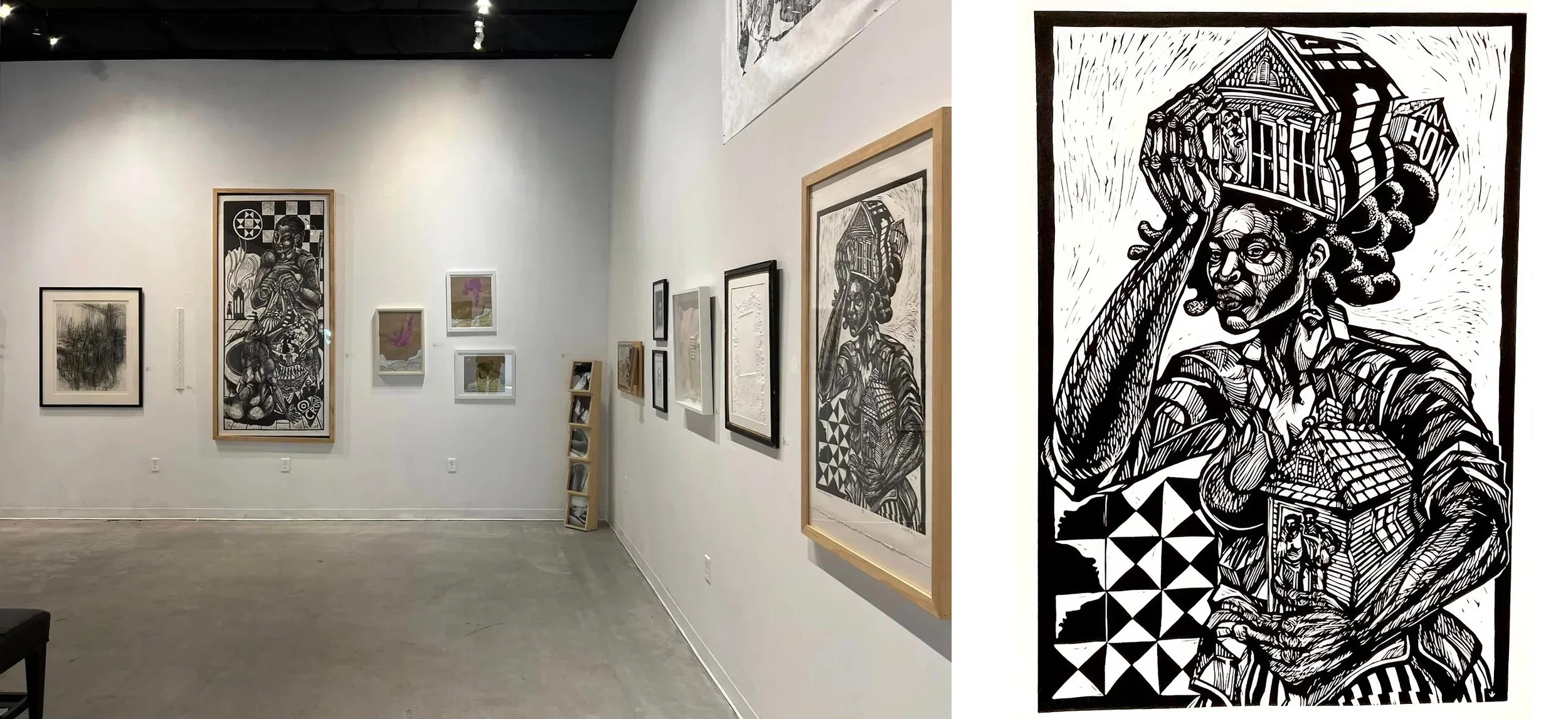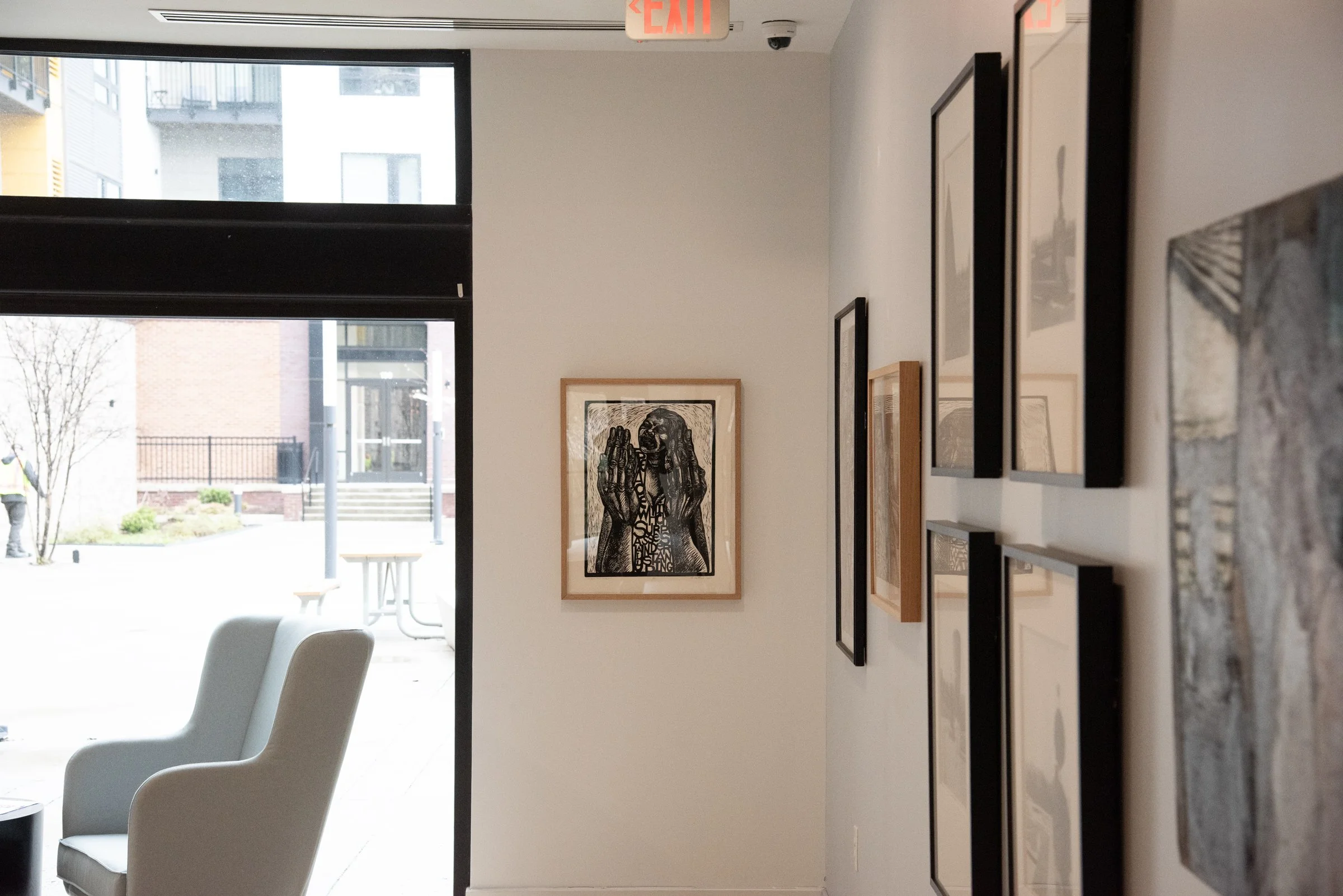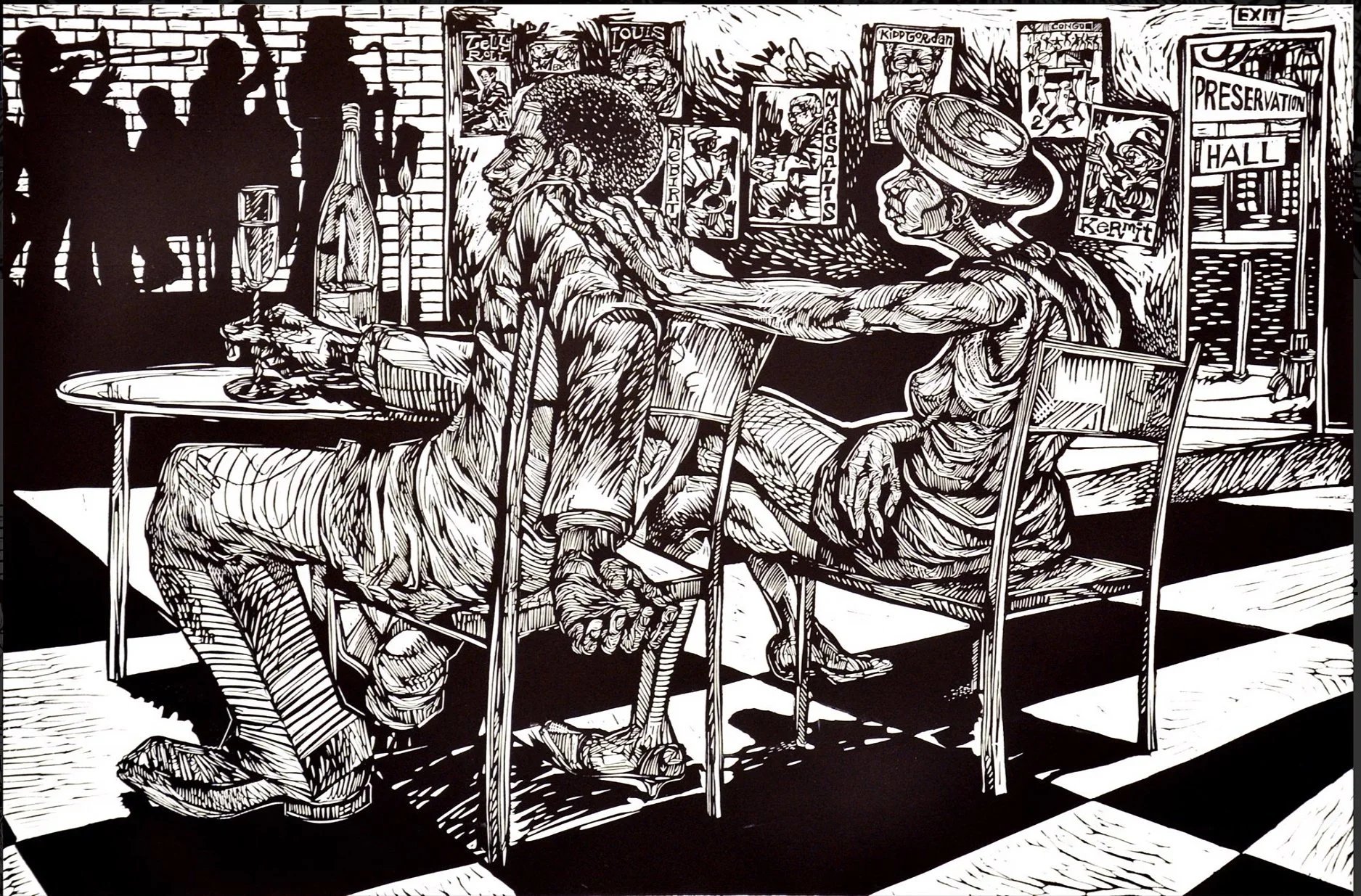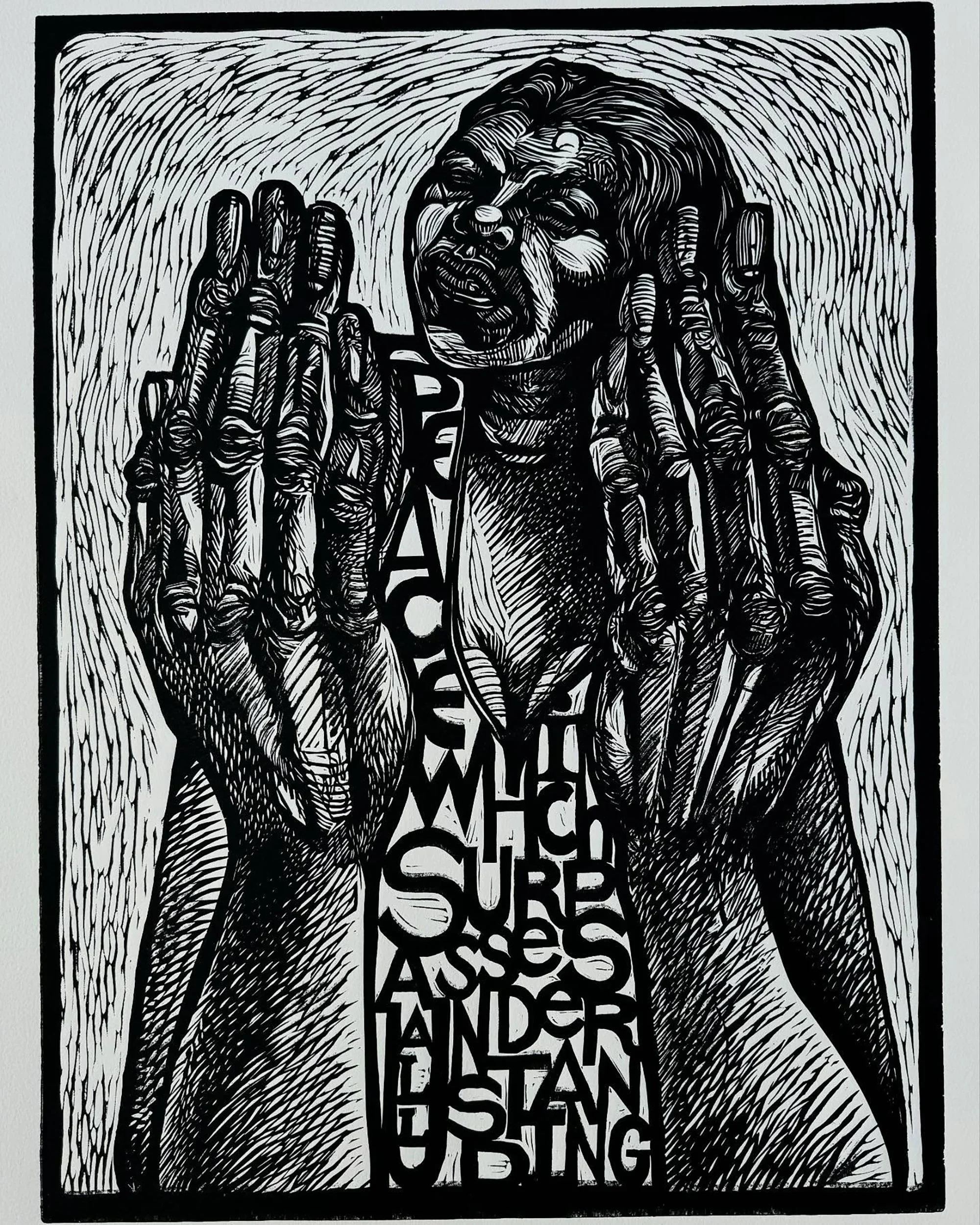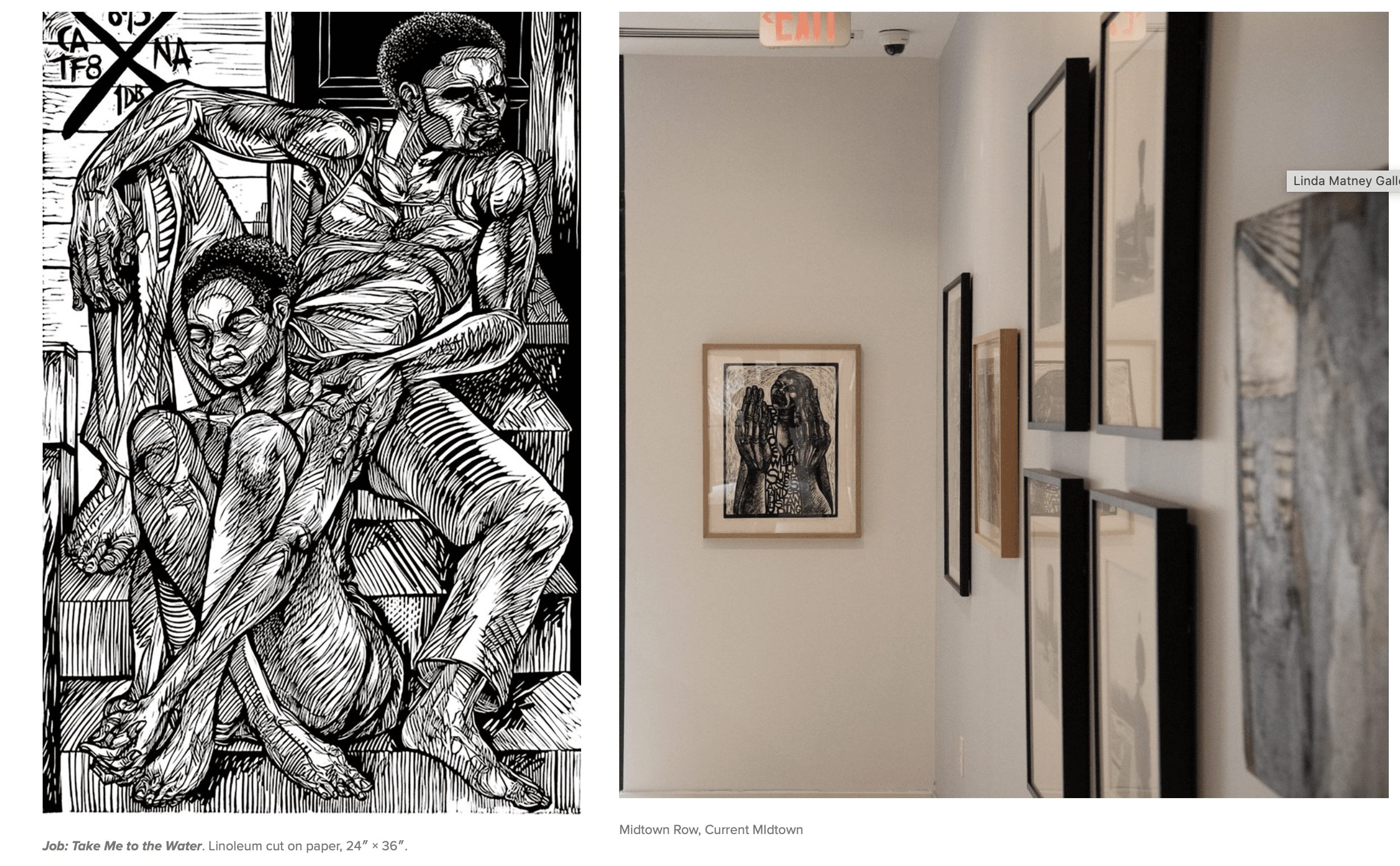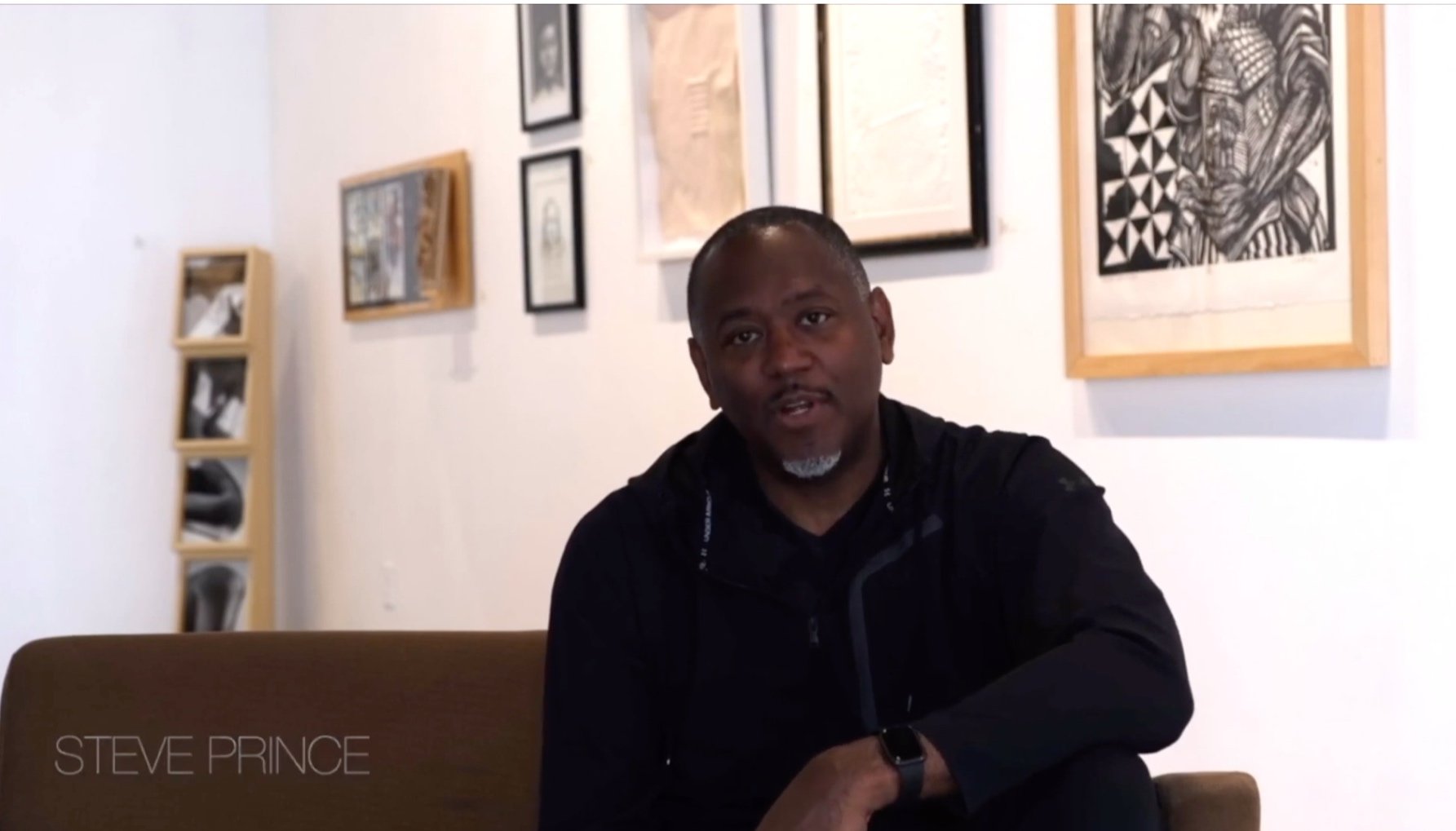On the Line, Linoleum Cut, 18” x 24”, 2024
Matney Gallery is honored to present A Rolling Conversation With Steve Prince, an in-depth exploration of the life, practice, and philosophy of one of the most compelling cultural voices in contemporary American art. Prince, a native of New Orleans and currently the Director of Engagement and Distinguished Artist in Residence at the Muscarelle Museum of Art at William & Mary, has long stood at the intersection of social justice, spirituality, and community through his dynamic visual language.
A master printmaker, sculptor, and educator, Prince’s work is rooted in the visual and sonic traditions of the Black South, particularly the transformative ethos of the New Orleans Jazz Funeral. His imagery—layered, symbolic, and spiritually charged—speaks to collective struggle, resilience, and redemption. Through woodcuts, drawings, performances, and participatory installations, Prince has consistently bridged the gap between fine art and public engagement, often turning viewers into co-creators.
This conversation—rolling in spirit and movement—dives into the rhythms that shape Prince’s work: the cadence of faith, the improvisation of jazz, the echoes of history. In sharing this dialogue, Matney Gallery offers audiences a window into the artist’s process, his commitment to healing and dialogue, and his belief in the power of art to transform both individual and community.
We invite museum professionals, collectors, and fellow artists to consider not only Prince’s formidable artistic accomplishments but also his role as a cultural connector—whose work transcends the studio to activate spaces of listening, making, and shared transformation.
Installation/ Works on Paper 2023
A Rolling Conversation with Steve Prince: Beginning with Works on Paper 2023
Hello, my name is Steve Prince and I'm a visual artist living here in Williamsburg, Virginia. I primarily work in drawing and printmaking. The pieces I’ve included in the show at Lee Matney Gallery are part of my relief practice—linoleum cuts and woodcuts. It’s a process I began as an undergraduate at the University of Louisiana and continued into graduate school at Michigan State. It has remained central to my career because of the many possibilities it offers in terms of marks and mark-making, and also because it allows me to create multiples that I can send out and disseminate to many people.
At its core, my work is deeply engaged with messages and stories. It is rooted in history and in the ways I’m able to take the narratives around me and encapsulate them within the work—not only as social commentary, but also as a means to speak about the human condition and point us toward a place where we can move beyond the constraints of stereotypes and the constructed ideas of Blackness and whiteness. I address the damaging repercussions of slavery and what those impacts have done not only to our nation but to our planet. My work speaks to those past ills while also pointing toward a more collective and unified body.
I think about the idea of the kitchen table often, and about the privacy of that space within people’s homes and what takes place there. It’s a necessary space in our daily lives because we need food to live, but it’s also a site where stories are shared, where history is passed on, where stories that shape us and inspire us emerge, and where stories that may even make us angry come forward. Ultimately, it’s a place where we let our hair down, where we speak in a casual tone rather than in the constructed narrative voice we present to the world. I’m interested in how we can create more spaces of authenticity like that, where we can share openly and truly see one another through the lens of being a family and a communal body.
The piece True Vine that I put into the exhibition is an image I created while in residence at the University of Tennessee in Knoxville. I was there during the pandemic, and it was both a beautiful time and a very challenging one for our nation and for the world. They housed me in a trustee house on campus, and each day I would walk about two blocks to the studio and carve this piece. I completed it in about a week. I laid the block on a table and carved every day for about three days, and upon finishing it, the art department printed the piece and produced a small edition from the block.
Before I arrived, I did some research on the community, and one of the things I focused on was learning about the Black community there. I discovered a street called Vine Street, which had long been a central hub, the Black mecca of the area. It was where the barbershop, the beauty salon, the convenience store, the movie theater, and all the places that serve as tributaries for daily life were located. That strip was the heart of the community. And when I think about communities across the country, there are always these main spaces where people cluster, whether it is the Black community, the Latino community, the Italian community, or others.
And then they create a world within a world. That was one of the things I researched about the area, and I wanted to create a piece that paid homage to that while also looking at the present and toward the future. If you look closely at the piece, you will notice that on the right-hand side there is a Vine Street sign. Below it is a group of musicians who played a song in the 1940s called Vine Street Rag, also known as Vine Street Drag. The musicians are performing, and one of them is playing a makeshift bass built from a washbasin with a pole attached from the bottom. They are playing that jam, and you can find the song I am referencing.
I thought about the foundations of hip hop, and how hip hop takes songs from the past, recycles them, and brings them into the present. It takes the old and makes it new. So I included a figure on the wheels of steel, mixing, with crates of albums beneath the table. Below the crates, I placed the floorboards of the room, and on the tops of those boards are bodies alluding to the transatlantic slavery experience. One of the boards is lifting up, rising in a way that suggests a spirit. On its surface is a heart, and the form wraps upward, conspicuously creating the shine of a cross on the pole. And there is a small leaf emerging from the side of the body.
And that leaf is alluding to the idea of the true vine. If you think about Christ’s first miracle, it was the moment he turned water into wine. He was the true vine, and his blood became the spiritual answer that broke open the foundation of Christianity. As you move through the image, you also see a couple dancing back and forth. Their movement embodies a call and response. It is a very sensual dance between them, with the woman’s body pushing forward, the man’s body pushing back, and then returning toward her again. You see her leg kicked out, his legs kicked out, their bodies intertwined almost like a pretzel-like configuration.
Steve Prince, True Vine, 2020, Woodcut on paper, 48 × 96 in | 121.9 × 243.8 cm
If you look at his right hand, the one casting behind him, he’s holding a handkerchief. That detail alludes to my upbringing in New Orleans. In that context, the white handkerchief symbolizes the Holy Spirit. In the Black community, it became expensive to release doves at funerals. Traditionally three doves were released, representing God, the Father, and the Holy Spirit. At weddings, one dove is released to symbolize two becoming one. As the practice became too costly, it was translated into the use of a white handkerchief. So when you see people dancing with the handkerchief and spinning it through the air, that handkerchief is, in essence, a dove. It becomes embodied through their movement.
If you look at the very edge of the handkerchief in his hand, I shaped it to resemble a bird’s beak or head extending from the cloth. Moving behind him to the left, you’ll see couples dancing. The two figures represent bodies as protest, with signs emanating from their hands. Their movement speaks to resistance to conformity and resistance to the constructions that try to contain us. It reflects the idea that our bodies naturally resist being placed in a box, and that the way we move pushes back against imposed structures. Beneath their feet, there is the arc of a globe. On the right side is the continent of Africa, and moving left you see North America, South America, and the Caribbean resting at the top of the globe they are dancing upon.
And so I am speaking again about the global effects of that Vine Street, the global effects of that true vine, and the global effects of that connection. If you look carefully, you’ll notice that every single element in the composition is touching the next. Everything is connected. That speaks to the true vine and to the interwoven nature of the composition that I wanted to convey to viewers. What I am trying to do is tell stories that are specific yet universal. They speak to my own upbringing, but they also point to the ways all of us have been raised, and to the spaces, wrinkles, and facets that tie into our lives and connect us. It does not matter who you are, because we all share this human experience.
STEVE PRINCE — HALLELUJAH ANYHOW AND SOW
Steve Prince’s linocuts Hallelujah Anyhow and Sow function as narrative anchors within his broader printmaking practice. Both works extend the visual and conceptual language introduced in True Vine, merging autobiographical reverence with communal memory. Rooted in the traditions of the Black church and the social rituals of Southern life, these pieces carry the same urgency and intimacy as Prince’s spoken reflections. They are visual parables, built with the same intent: to carve remembrance into the cultural record.
Hallelujah Anyhow
This print embodies praise in defiance of weight. A woman stands upright, bearing the literal structures of home—rooftops, walls, entire buildings—balanced upon her head and hip. Rather than strain or collapse, she meets the viewer’s gaze with quiet authority. Her stance resists erasure; it insists on visibility.mThe piece draws on the tradition of African American spirituals and the gospel ethos of “praising anyhow,” a cultural theology of joy forged in the crucible of suffering. Prince’s formal approach reinforces this message. Linocut lines become rhythmic cadences, the carved surface echoing the choral structure of a communal song. The result is a choreography of resolve, where burden and beauty occupy the same frame. Editioned and widely exhibited, Hallelujah Anyhow offers museums and collectors a resonant entry into Prince’s visual theology, a spiritual realism that renders everyday endurance as sacred labor.
Steve Prince, Sow, 2020, Linoleum cut,, 84 × 36 in | 213.4 × 91.4 cm, Edition of 1 + 1AP.
Sow
Commanding in scale and epic in tone, Sow memorializes four generations of women from Prince’s lineage. The vertical format reads like a devotional scroll, where each figure becomes both subject and steward, carrying forward ancestral wisdom through care, resilience, and embodied knowledge. Rather than romanticize the past, Sow animates its labor. The figures sow not only seeds but ideas, ethics, and memory. Through formal motifs—extended limbs, curling linework, and gestural repetition—Prince transforms familial tribute into mythic architecture. The result is an image of matrilineal power rendered monumental, not in grandeur, but in gratitude. Editioned in a deliberately limited release, Sow retains the gravity of a singular vision while maintaining Prince’s ethos of accessibility through print. Its presence in prominent institutional exhibitions affirms its significance as a work that bridges personal testimony and collective heritage.
STEVE PRINCE DISCUSSES HIS WORK ON EXHIBIT AT MIDTOWN ROW
Lee Matney: Discuss your work in our current exhibition at Midtown Row
Steve Prince: One of the pieces I have on display is called Ezra: Reparations Groove. It shows a couple sitting at a table, listening to jazz music. In the background, I’ve included references to different eras of music: I have Sidney Bechet, the Rebirth Jazz Band, Kermit Ruffins, and Ellis Marsalis. There’s also an image of a poster by John Scott titled Congo Square. John Scott was one of my professors during undergrad, and I have a deep connection to that piece. As a student, I helped assist with a professional edition of that poster: a company was hired to screen print it, and a few of us students were brought in to help number the prints while John Scott signed them. We then rolled them up and packed them into tubes.That piece was sold, and I still remember working on it as a student. So, Ezra Reparations Groove is also an homage to a man who was instrumental in my journey to becoming an artist. Within the image, I trace a historical line of jazz musicians who had a major impact not just on music, but also on the social fabric of New Orleans. The setting where the couple is listening to music is symbolic too: it's Preservation Hall, located on Bourbon Street, a space known for preserving musical history. In that way, the piece also speaks to the preservation of culture through both music and visual art. There's a kind of layered storytelling happening in the work.
Guard My Heart, Linoleum Cut, 18” x 24”, 2024
Guard My Heart is one of newest pieces . I created it while I was in residence at the University of Chicago’s Lab School — a pretty famous school, notably where Barack Obama’s daughters studied before he became president. The woman depicted in the piece has a scripture verse running down her body: “Peace, which surpasses all understanding.” The idea of “the Word made flesh” is something I was trying to communicate compositionally The piece also pays homage to some of the great African American artists who have influenced me over the years — artists people may or may not know. John Biggers, Charles White, Elizabeth Catlett, Charles Alston, and I would also add Lois Mailou Jones. These artists often exaggerated anatomy in their work, and I reference that tradition: in this piece, the woman’s hands are oversized. Of course, I understand correct proportion, but that's not the point — the hands are exaggerated to symbolize vessels of protection, nurturing, and knowledge. Enlarging the hands enlarges her praise. Her eyes are closed, suggesting a spiritual protection that envelops her body. The hands also reference the historical labor of hands: hands that worked the fields, raised children, chastised, fed mouths, created art, communicated, sang, lifted up, pushed down, fought, and protected. All of that is intentionally woven into the image.
On the Line, Linoleum Cut, 18” x 24”, 2024
Another recent piece of mine is called On the Line. It’s a simpler image, but it connects to the tradition of quilting — something I’ve long admired: the idea of creating something beautiful from discarded materials. In the piece, a woman is hanging a quilt out to dry. The quilt is composed of patches, each alluding to a different historical reference — each patch carrying its own story. The title On the Line plays on the literal and figurative meaning: the woman is putting her quilt on the line, but she's also putting her life, her survival, her protection of her family on the line. This piece is an homage to the extraordinary women in my life — my mother, my sisters, my wife, and so many others who have supported, challenged, lifted, and protected me. They’ve shown courage and strength, and exemplified the power to bring new life into the world — something I’ve witnessed firsthand, even if only from a supportive role. That awe for the life-giving power of women is a consistent thread in my work. It goes back to my graduate thesis, Images of the Invisible Woman: Definitions of Black Womanhood and the Struggle for Equality. Honoring women, particularly Black women, has been a throughline across my career.
The next piece is called Job: Take Me to the Water. This work is a nod to my upbringing in New Orleans. Behind the couple in the image, there’s an insignia marked with an X and various notations. At the top, it says "6/15" — June 15th. On the right side, it says "NA," meaning no animals were found inside. At the bottom, it reads "1DB" — one dead body. On the left, "CATF 8," indicating the team that inspected the building after Hurricane Katrina. After Katrina, teams marked structures this way to show whether living beings — animal or human — remained inside. I made this piece in response to the devastating loss I experienced after Hurricane Katrina — losing four aunts, an uncle, and later my mother. Although her passing wasn’t directly caused by Katrina, I believe her sorrow over the destruction of her beloved city hastened her death. If you look closely at the man sitting on the porch, you’ll notice a reference to Andrew Wyeth’s famous painting Gulfstream. In Gulfstream, a man sits alone in a boat surrounded by shark-infested waters after a storm. Though the tempest looms, he survives — and in the far distance, a ship appears, suggesting rescue. I invoke Gulfstream to symbolize survival against overwhelming odds. I titled the piece Job to allude to the biblical Job, who endured unimaginable losses — family, health, everything — yet never broke his faith. In the painting, the woman's legs cross in the shape of an X, her hands are clasped in prayer, and the man’s fingers gently pull at the strap of her dress — symbolizing the fragility of life (the thin red line of the bloodline) and the strength it takes to survive.Job: Take Me to the Water references both the literal floodwaters of Katrina and the spiritual waters of rebirth — the idea of baptism, of dying to the old self and being made new
Lee Matney: Thank you Steve, I appreciate your genorosity and commitment to the arts here in Williamsburg. Thank you for sharing your work and insights with our audience
Steve Prince: I truly appreciate these moments to come together with you, Lee. I appreciate what you're doing — not only collecting art for future generations but also building community around it. I see that as an extension of the kitchen table tradition — bringing people together across differences, amplifying diverse voices. I’m grateful that you find my voice meaningful in that effort, and I’m honored to share these stories with you and your audience.
INTERVIEW WITH STEVE PRINCE, THE BLOCK
AND I THINK THAT'S POWER, AND I THINK THAT'S SO POWERFUL FOR US IN WHAT WE DO AS CURATORS OF ART, AS MAKERS OF ART, AS COLLECTORS OF ART, AS SHOWCASERS OF ART, ALL THESE WAYS IN WHICH WE INTERACT AND ENGAGE ART. I THINK THESE ELEMENTS ARE JUST SO IMPORTANT BECAUSE IN ESSENCE, WHAT YOU AND I ARE DOING IS PRESERVING HISTORY. WE'RE PRESERVING SOMETHING THAT'S GOING TO OUTLAST BOTH OF US THAT GETS PASSED ON TO SOMEONE ELSE. AND I LOVE THE FACT THAT THE SIGNIFICANCE OF THIS MOMENT THAT WE ARE SITTING HERE TOGETHER TALKING AND ENGAGING, AND THIS IS IMPORTANT THAT WE ARE LIVING, BREATHING, WE BOTH GOT ALL OF OUR FACULTIES AND WE ARE ABLE TO TALK ABOUT THIS WORK.
STEVE PRINCE, 2025
Hi, this is Lee Matney of the Matney Gallery. I'm here with Steve Prince, distinguished artist in residence and director of engagement at the Muscarella Museum of Art. Hi Steve. What it's new in your practice?
Steve Prince: I have several different things going on. One of the last pieces I created was over at East Carolina University—a piece called The Block. It’s a pretty epic vinyl cut, measuring two feet by seven feet. I partly based it on the history that circulates around the Black community in Greenville, North Carolina, as well as around East Carolina University.
Interestingly enough, the history I referenced in the piece, for lack of a better word, exposes itself. It’s a story you’ll find in many communities across the United States—Black communities that were thriving within spaces of constriction, where they weren’t allowed to thrive in terms of access outside of their space. But they still found a way—made a way out of no way—within the context of their own communities.
And I find myself making work about that over and over again. I think what happens is that I begin to reflect upon my parents and their struggle, and I reflect upon my father. The fact that my father had artistic acumen, but it was a dream deferred—something he was unable to accomplish because of the times he grew up in, because of the constraints of those times. But my parents, of course, worked very hard and created space for me to do what I do. It is only fitting that I pay homage to those who did so much to create a space for me to do something that they were denied. So when I make this piece The Block, I’m reflecting not only upon the community I descend from, but also upon the community that I was reared in
In that image, I pay homage to a woman named Laydonna Wright. Laydonna Wright was an advocate for African-Americans' healthcare concerns. Then there was another woman named Francis Hopkins, who did something very similar to what a man named Blaine Blayton did here in Williamsburg. Black people weren’t allowed to access different hospital spaces, so instead of complaining about the situation, they created their own. Blaine Blayton in Williamsburg created a hospital for Black people, and Francis Hopkins turned her house into a hospital. She was a nurse, and she wanted to ensure that people received proper medical care and didn’t die from treatable conditions, allowing them to live longer, healthier lives.
In that same composition, I have a character I’ve been incorporating into several pieces now—my Grio character, which is my storytelling figure.
This person is’s timeless—she’s the past, the present, and the imagined future. I’ve used her three times recently. First, I used her in The Block, then in a piece called Peace Quilt which is the mural here in Williamsburg that we discussed in the podcast on your site. I also used her in a piece called Peace Table, which is part of an exhibition at the Jordan Schnitzer Museum at the University of Oregon. This woman recurs over and over again, and in the piece I did for East Carolina, She’s holding a Sankofa staff in her hand. The Sankofa is a mythical bird from Ghana, Africa, that moves forward while looking back..
And then inside that image there is an homage to the corn, the tobacco, the cotton, and the sugarcane, and those different crops that those bodies were subservient to and building industries that are still living in this nation was made upon their backs. They're almost like sedimentary rock or sedimentary soil that has been built upon their bodies.
And so also in that image I showed the every day a woman braiding the hair of her loved one, a couple dancing on the street with a boombox going, which alludes to the 1980s and the burgeoning of hip hop and a lot of those musical forms coming out of New York and out of California and out of Chicago. And there's musical forms of which we know is hip hop that has spread globally. And also in that image is a guy grilling, just making some food and flipping some burgers and some dogs.
Those things that we know of in the everyday that even in the midst of our pain and our struggle, we still find places of respite and that's in there. And then I end that piece with a couple of really heavy concepts or constructs. One, there is a funerary march that's happening inside the composition. And that dirge is a person's being carried on into the afterlife, but then walking right beside it as a mother with child, with child, there's a child that she's walking beside, but she's also pregnant. So as that life leaves, another life is coming in its place. And I think that that be speaks of those kinds of things, of those generations. It be speaks of the idea of the Sankofa to get us to remember to remember as we go forward. And then there's a house in the background.
Because one key thing, Lee, is when I was traveling from Williamsburg and going to East Carolina, going to Greenville to do this work, I passed through Edenton, North Carolina, and not many people know the history of circulating around Edon North Carolina. There was a woman by the name of Linda Brent who wrote under the pen name of Harriet Jacobs, and she wrote a book called Incidents in the Life of a Slave Girl. And in that book, she basically talks about escaping from the overtures, the sexual overtures of her slave master by hiding in the attic space of a grandmother's house for seven years. That's extraordinary with this woman, the lens that she goes through to hide away from this terrorism that's happening to her body. And the only reason why she did that, she didn't flee. It's not that she couldn't, she didn't because just as many other women did.
She had two children that she wanted to stay near and she did not want to leave her kids behind. So these extraordinary stories that are embedded within the fabric of our nation that shape us, I think is so important as the artists to be able to tell them and to share these stories, to be truths sayer. And it ties right back to the other piece I told you called Peace Table, which is about 42 inches in diameter. And that piece that I created, I literally carved the table, carved out the message there. So when everyone that comes to that table and touches it, they are reminded of that history and all that gets embedded within that space and that table becomes a silent participant. And all that happens in the context of the sacred space of a kitchen and then the mural.
I love doing that piece here in Williamsburg as an extension to what I do as an artist along with galleries and museum spaces that you and I work in. But the mural is this public space that is not meant to be there forever. And I love that. I love the temporality of it because in essence, the mural is just like us. It's like a living, breathing entity that is out in the public to consume, but over time it will wither away. So it's here for a little while. Then I love the fact that we are in this kind of medium that we in essence get to keep at least a memory of it alive and we got photographic references of it, and then there's just going to be a small sector of people that actually saw it.
And I think that's power, and I think that's so powerful for us is what we do as curators of art, as makers of art, as collectors of art, as showcases of art, all these ways in which we interact and engage art. I think these elements are just so important because in essence, what you and I are doing is preserving history. We're preserving something that's going to outlast both of us that gets passed on to someone else. And I love the fact that the significance of this moment that we are sitting here together talking and engaging, and this is important that we are living, breathing, we both got all of our faculties and we are able to talk about this work.


